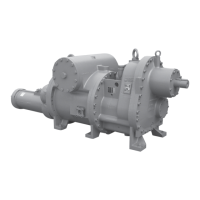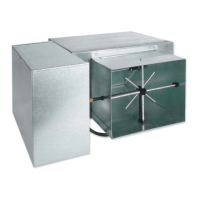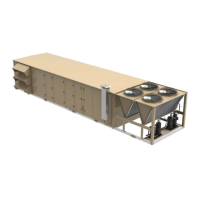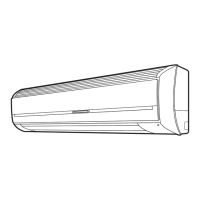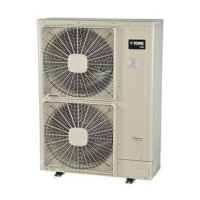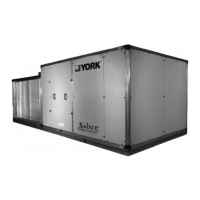JOHNSON CONTROLS
104
FORM 100.50-NOM12
ISSUE DATE: 04/02/2019
SECTION 5 – SEQUENCE OF OPERATION
• When the current building pressure is less than the
building pressure setpoint plus the building pres-
sure control offset, the exhaust fan is turned OFF.
Modulating Damper - VFD
• This power exhaust type is used for two different
sequences:
1. Modulating damper with single speed ex-
haust fan
2. Modulating exhaust fan with barometric
damper
• How the unit operates is based on how it was or-
dered. Both of these sequences utilize the exhaust
damper output for controlling the exhaust fan.
1. Modulating damper with single speed exhaust
fan: The 0–10 VDC signal is sent from the ex-
haust damper output to the exhaust damper ac-
tuator.
2. Modulating exhaust fan with barometric
damper: The 0–10 VDC signal is sent from
the exhaust damper output to the exhaust fan
VFD.
• The 0–10 VDC signal sent from the IPU board
directly correlates to a 0–100% damper position
or VFD speed.
1. Modulating damper with single speed ex-
haust fan: For example, a 2.5 VDC signal is
an exhaust damper position of 25%.
2. Modulating exhaust fan with barometric
damper: For example, a 2.5 VDC signal is an
exhaust fan VFD speed of 25%.
Modulating Damper with Fixed Speed
Exhaust Sequence of Operation
• Power exhaust type must be set to Modulate Damp-
er - VFD in the OPTIONS-EXHAUST menu.
• Building pressure setpoint must be set in the SET-
POINTS-EXHAUST menu.
• Exhaust output for fan start must be set in the
SETPOINTS-EXHAUST menu.
• Exhaust Output for fan stop must be set in the
SETPOINTS-EXHAUST menu.
• This sequence uses a modulating exhaust damper
with a single speed exhaust fan.
• When the current building pressure becomes
greater than the building pressure setpoint, the
IPU board starts sending a 0–10 VDC signal to
the exhaust damper actuator.
• When the exhaust damper position is greater than
the exhaust output for fan start, the exhaust fan is
turned ON.
• When the exhaust damper position is less than
the exhaust output for fan start, the exhaust fan is
turned OFF.
Modulating Exhaust Fan with Barometric
Damper
• Power exhaust type must be set to Modulate Damp-
er - VFD in the OPTIONS-EXHAUST menu.
• Building pressure setpoint must be set in the SET-
POINTS-EXHAUST menu.
• Exhaust output for fan start must be set in the
SETPOINTS-EXHAUST menu.
• Exhaust output for fan stop must be set in the
SETPOINTS-EXHAUST menu.
• When the current building pressure becomes
greater than the building pressure setpoint, the
IPU board starts sending a 0–10 VDC signal to
the exhaust fan VFD.
• Once the exhaust fan speed signal, (exhaust damp-
er position on the LCD screen) is greater than the
exhaust output for fan start, the exhaust fan VFD
is started.
• Once the exhaust fan speed signal (exhaust damp-
er position on the LCD screen) is less than the ex-
haust output for fan stop, the exhaust fan VFD is
stopped.
Exhaust Fan Control: BAS Sequence of
Operation
• The Series 100 units have the ability to allow a
BAS to control the exhaust fan assembly.
• This option allows a controls company to send a
BAS signal out to one or more Series 100 units,
which controls all exhaust fans at the same speed.
• Power exhaust type must be set to Modulate Damp-
er - VFD in the OPTIONS-EXHAUST menu.
• Exhaust control BAS must be User Enabled in the
SERVICE menu.

